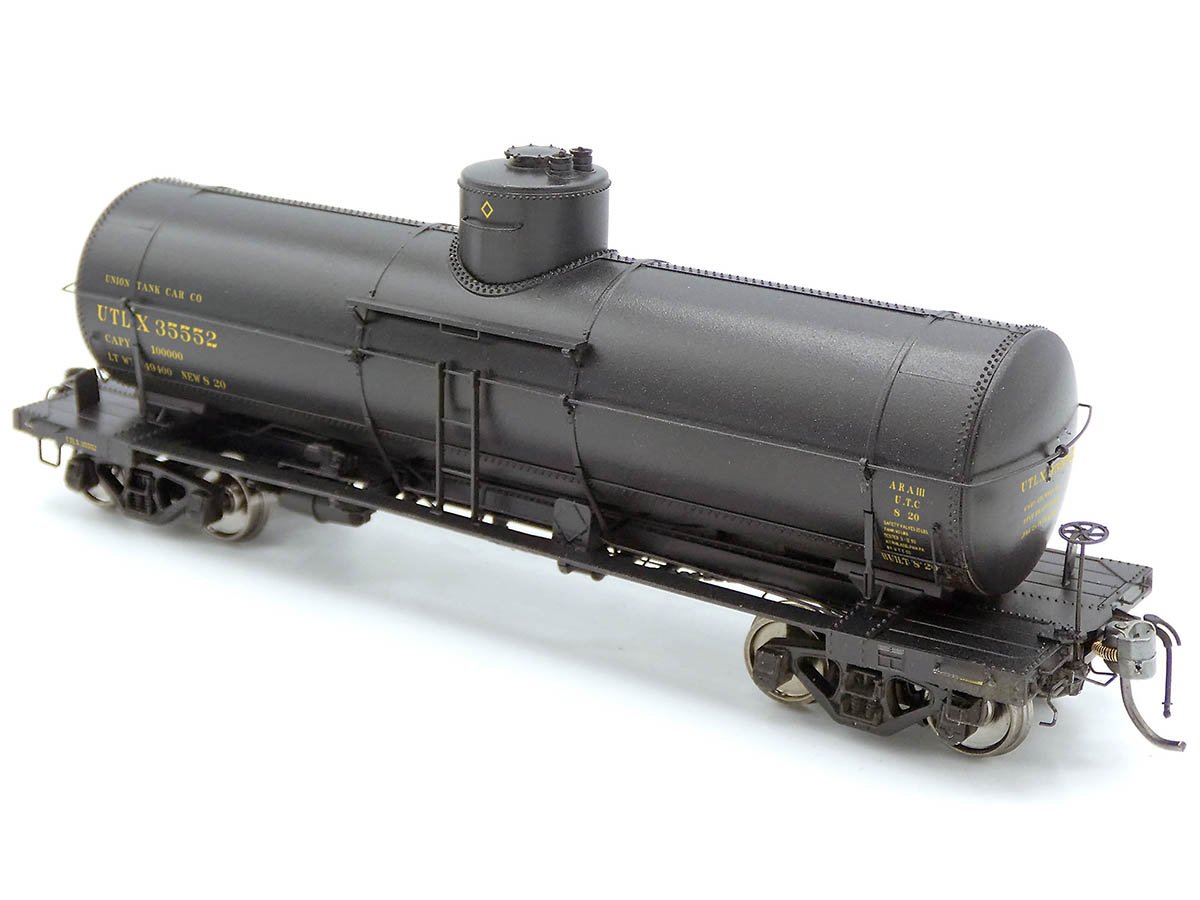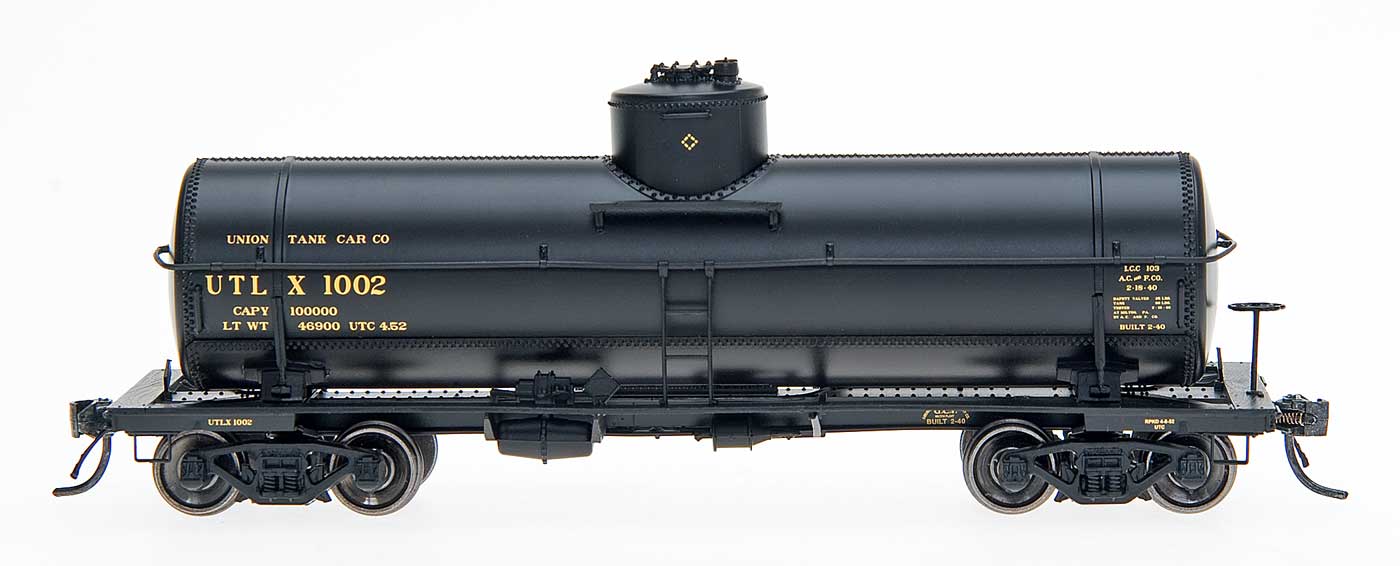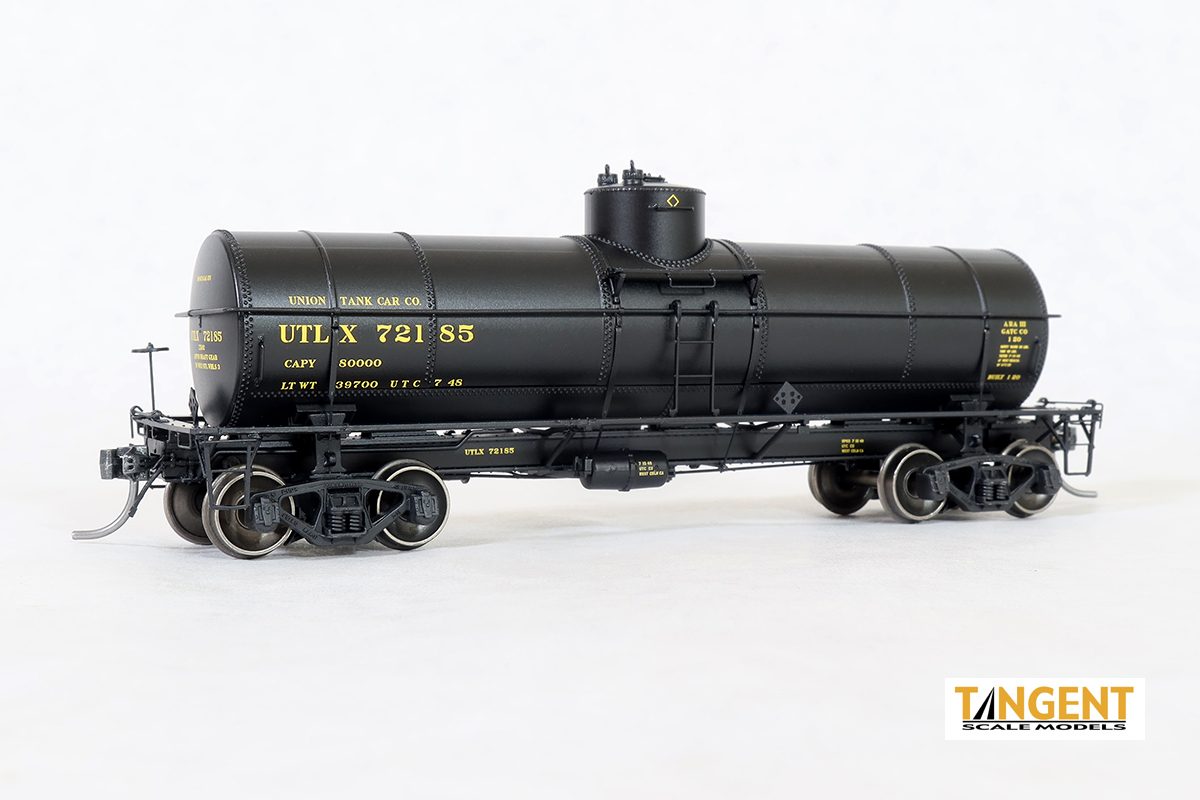Over the years in HO-scale, we've had a number of accurate and correct models of UTLX tank cars. Yet, they still missed the mark if you wanted to have more than one or two cars. "Why?" You ask. Well, UTLX was the dominate private tank car leasing company of the 20th Century with a fleet numbering 42488 cars in the 1950 ORER. That's a lot of tank cars! So if there's accurate models out there, what's the problem?
The problem is that Union Tank Car Line was owned by Standard Oil, which was split up with anti-trust lawsuits in the early 20th Century. The Union Tank Car Company built their own designs of tank car for UTLX, resulting in 13,000 of cars of the same 10,000 gallon X-3 design making up their fleet.
 |
| New 2022 pre-production UTLX 10K X-3 tank car by Rapido!- Photo linked from Rapido's website |
The problem is that Union Tank Car Line was owned by Standard Oil, which was split up with anti-trust lawsuits in the early 20th Century. The Union Tank Car Company built their own designs of tank car for UTLX, resulting in 13,000 of cars of the same 10,000 gallon X-3 design making up their fleet.
However, these are not the models we've had until now. No, the models of UTLX cars we have available until now, are the odd-balls from smaller petroleum and chemical companies that were acquired through mergers with Union Oil or decided to get out of the transportation business and sell their tank cars to UTLX and lease a few cars from UTLX's vast pool of cars to suit their needs. The result is a very large fleet of standardized cars, with a few odd-balls from other manufactures. Let's look at what's currently available or has been produced by mid-2022. I'm not going to list the earlier tank cars built before 1915, as many of those didn't meet later standards of ARA and AAR, and were mostly gone by the end of WWII.
A quick note about researching tank cars in the ORERs. It was up to the railroad/company to provide as much information or as little information to the AAR to make the register. The PRR for example goes so far as to provide which class each entry is. UTLX is very minimal; Car number, weight capacity, and a possibly one of 6 special notes to change individual cars within the number block to other weights, lining, acid, etc. warnings. So short of looking at photos of indivitual cars within the series, there's not much information out there to rationalize the fleet.
- Tangent Website
Edit: After consulting with David Lehlbach at Tangent, their using Tank Car Tariff data from 1936 and 1955 for their steam era tank car models. So given this car's rebuild/tare date as 2-1949 date and the Tangent research, I'm going to say these cars existed the way they are modeled. It would be great for the WWII to 1955 modeling community if more Tank Car Tariffs could be found as they are much more specific about the national tank car fleet than the ORER. The ORERs are good for researching basically any other car type than tank cars!
A quick note about researching tank cars in the ORERs. It was up to the railroad/company to provide as much information or as little information to the AAR to make the register. The PRR for example goes so far as to provide which class each entry is. UTLX is very minimal; Car number, weight capacity, and a possibly one of 6 special notes to change individual cars within the number block to other weights, lining, acid, etc. warnings. So short of looking at photos of indivitual cars within the series, there's not much information out there to rationalize the fleet.
The UTLX company has cars spread throughout nearly 100,000 numbers but only 42,488 cars in service. This suggests large holes in the number series. From the ORER Notes, even the larger series are broken up with cars of differing capacity or specialization within larger number blocks. Some number series may also indicate where the cars came from or large customers or divisions of the company that have whole blocks of cars assigned to them. Unfortunately, much of that in-company knowledge is probably lost to history at this point.
I will also note that Union Tank Car has four sets of reporting marks: UTLX, UTCX, UTX, and PX. The notes at the end of the ORER entry state that all cars of these reporting marks can be billed as one account. It is also noted that UTLX is listed as Products Tank Line of Canada, LTD, showing how it is incorporated. This may explain the origin of the UTCX as Union Tank Canada?
Home Points:
Bayonne, NJ,
I will also note that Union Tank Car has four sets of reporting marks: UTLX, UTCX, UTX, and PX. The notes at the end of the ORER entry state that all cars of these reporting marks can be billed as one account. It is also noted that UTLX is listed as Products Tank Line of Canada, LTD, showing how it is incorporated. This may explain the origin of the UTCX as Union Tank Canada?
Home Points:
Bayonne, NJ,
El Dorado, Kan,
El Segundo, CA (near LA),
Milton, PA,
Neodesha, Kan.,
No. Baton Rouge, La.,
Olean, NY,
Philadelphia, PA,
Richmond, CA (north of Oakland),
Sharon, PA.,
Whiting, Indiana,
Wood River, Ill.
General American Tank Car (GA)
Type-17 - Tangent Models
The GA Type-17 was introduced unsurprisingly in 1917 and lasted into the 1960s. Some of these cars made their way through various owners into UTLX reporting marks by the 1930s and 1940s.
10K Gallon - Produced 2018
 |
| UTLX 10673, leased to Hercules Powder Co. |
Tangent didn't offer this model in the standard UTLX general leasing black scheme. I have two of these Hercules Powder cars for the Tehachapi Pass traffic to the Bay Area. I also picked up two painted unlettered cars. So I may end up using UTLX decals to make my own general service model, the other I plan to kitbash into an ex-EPSW, turned SP fuel oil car. But back to the UTLS cars, only 198 cars are shown in the 1950 ORER for the 26-12749 series of 40-ton cars are rated with the note exception to 50-tons capacity. None match with this number series, so not sure how to resolve this discrepancy.
Hold It, Hold It! Correction Time!
 |
| UTLX 10673, 10K GA Type-17 - Leased to Hercules Powder Company (explosives & gun powder). |
Edit: After consulting with David Lehlbach at Tangent, their using Tank Car Tariff data from 1936 and 1955 for their steam era tank car models. So given this car's rebuild/tare date as 2-1949 date and the Tangent research, I'm going to say these cars existed the way they are modeled. It would be great for the WWII to 1955 modeling community if more Tank Car Tariffs could be found as they are much more specific about the national tank car fleet than the ORER. The ORERs are good for researching basically any other car type than tank cars!
UTLX 10673 - 1949 Hercules Powder 10K Type-17 Tangent Models Archive - with additional information about chemical shipments by Hercules Powder to various customers around the country.
Hercules Powder also had a powder works along the San Francisco Bay, north of Richmond and Oakland at Giant. So seeing these cars crossing Tehachapi would certainly be possible.
8K Gallon - Newly Announced Run Oct 2022, Previously 2016
I never picked up this version for UTLX, so I'm using the linked stock photo from Tangent's page. Checking the 1950 ORER, the UTLX 71000-79999 series had 4455 cars of 40-tons (probably 8k capacity), 794 cars of 50-tons (probably 10k capacity) and two other cars with special linings in that series. The 4455 car block shows that this is one of the larger groups of cars. I should note that Proto2000 has also produced their ACF Type-21s in this same number series, so not all of the 4455 cars rating at 40-tons are these GA Type-17s. In either case, I'm going to snag one of these new run cars before they sell out.
New run of GA Type 17 UTLX 8k models - Oct 2022
New run of GA Type 17 UTLX 8k models - Oct 2022
NightOwlModeler blog: UTLX Tank Cars (Part 2) - Tangent GA Type 17, 8k Gallon Tankcar Review
American Car & Foundry (ACF)
Type-21 - Proto2000/Walthers - Late-1990s to Present
10K Gallon
 |
| UTLX 10343, ACF Type-21 10K tankcar, photo linked from Walthers website. |
Proto2000 released the 8K gallon version first, then a couple years later the 10k uninsulated version came out. Proto2000 are supposed to be historically correct numbering. Interestingly, this series overlaps with the new Tangent Models GA Type 17 8k models. Only 198 cars in the 26-12749 series were rated for 50-ton weight capacity, suggesting how few Type 21 10k and GA type-17 10k cars there can be in these number series.
The older kits that I have of this car show numbers in the 60k-series (UTLX 60350 is one I have), which seems to be correct in that it's a 50-ton car and not in a noted series of 40-ton cars within that series. The 60000-67999 series consists of 4493 cars of 50-tons capacity (probably 10k gallon cars) with 555 rating at 40-ton capacity (presumably 8k gallon cars).
The older kits that I have of this car show numbers in the 60k-series (UTLX 60350 is one I have), which seems to be correct in that it's a 50-ton car and not in a noted series of 40-ton cars within that series. The 60000-67999 series consists of 4493 cars of 50-tons capacity (probably 10k gallon cars) with 555 rating at 40-ton capacity (presumably 8k gallon cars).
8K Gallon
%208K-A2.jpg) |
| UTLX 77640, ACF Type-21 8K Gallon. Looks like this one is missing the dome platform. JHill photo 2011 LMRC Roster. |
Unfortunately, most of my P2K UTLX Type-21s have either not been built or took damage like this one. Proto2000 are supposed to be historically correct numbering. Interestingly, this series overlaps with the new Tangent Models GA Type 17 8k models in the 71-80k series, so it would seem that the 4455 cars in that series that are shown as 40-ton, 8k cars are not all the same mechanically.
10K Gallon - Insulated - Not Used by UTLX
Type-27 - Intermountain - Late 1990s to Present
10K Gallon
 |
| UTLX 1002, Type-27 10K tankcar - IMRC website photo linked. |
The ACF Type-27 tank cars are built on a longer frame and smaller diameter tanks than the Type-21s. The model shown, UTLX 1002, is in the middle of the lower end of the roster and falls within the Note B cars of 976-1026. Again, a very small group of cars considering the UTLX fleet size. IMRC currently shows the following numbers available:
Built (Tare Date): Built 2-40, UTC 4-52
Stock Number / Car Number
-37 982, -38 996, -39 1002,
-40 1007, -41 1015, -42 1028
Stock Number / Car Number
-37 982, -38 996, -39 1002,
-40 1007, -41 1015, -42 1028
It would seem that the 1028 is two numbers higher than the last 50-ton car and is back in the 40-ton, 8k gallon car number series.
Link to IMRC 10K UTLX models.
8K Gallon
 |
| UTLX 17362, ACF Type-27 8K gallon tankcar - IMRC website photo linked. |
The IMRC ACF Type-27 8K tank car is also built on the longer frame of the Type-27 design, with the smaller tank diameter. ORER shows the 16000-17799 series with 1437 cars of 40-ton, 8k gallon nominal capacity. Only two cars in the series have notes on being 30-ton capy, probably 6.5k gallon (UTLX 16121 & 16445) and 10 cars of 40-tons with special liners. (UTLX 17001, 17065, 17069, 17211, 17295, 17392, 17567, 17624, 17668, 17705 lined). So it seems IMRC came up with reasonable car numbers with their research.
Built: 7-37
Stock Number / Car Number
-07 17319, -08 17334, -09 17356,
-10 17365, -11 17371, -12 17382
Previously Released Numbers
-01 17308, -02 17317, -03 17330,
-04 17362, -05 17375,
-06 17389,
1948-1951 LPG Tankcar 11k Gallon - Atlas - Early 2000s
 |
| UTLX 96269, 11K gallon insulated, welded, 300PSI LPG tankcar from Atlas. |
Atlas produced a new set of tooling in the early 2000s replicating the ACF's 11k gallon LPG tankcar, while a little off-topic from the general service tank cars that I'm talking about in this article, I do want to point it out.
The UTLX 96012-99999 series are the new LPG cars totalling 2274 cars in the 1950 ORER with only 29 cars in the series showing as 40-ton cars, which are probably some other design. Both cars blocks in the series are classified as TPI = Tank, Pressurized, Insulated. The Atlas model represents the fairly standard of the late 1940s LPG car meeting the ICC-105A-300-W specification.
The UTLX 96012-99999 series are the new LPG cars totalling 2274 cars in the 1950 ORER with only 29 cars in the series showing as 40-ton cars, which are probably some other design. Both cars blocks in the series are classified as TPI = Tank, Pressurized, Insulated. The Atlas model represents the fairly standard of the late 1940s LPG car meeting the ICC-105A-300-W specification.
Union Tank Car (UTC)
UTC X-3
 |
| Rapido's pre-production UTLX 10K X-3 Tank car - Photo linked from Rapido's website |
The X-3 series of tankcar designs have been offered in resin, but never before in plastic tooling or R-T-R. So Rapido's announcement that they're doing a 10K gallon UTLX X-3 car is very good news, as we can finally balance out our steam-diesel era UTLX fleets.
10K Gallon - Rapido, new project 2022+
The first release of Rapido cars look like they're numbering into the 26000-42999 series, including 28714 in the 1920s version, 28941 in the 1930s lettering scheme, and 35552 is one of the cars in the 1950s version with AB brakes. This massive group of 17,000 numbers 6235 cars show active in 1950 with 50-ton (10k gallon) capacity and only 174 cars of 40-ton (8k gallon) capacity in the series. It doesn't appear that Rapido has announced exactly which numbers they'll be doing as of Oct 16, 2022. The numbers I meantioned here are what their render-artwork shows and one pre-production 1950s model is 35552. However, with 13,000 cars of the 10k gallon X-3 design, that accounts for almost 25% of the UTLX's whole fleet. So we can clearly see how we've been missing this very signature car in the steam era fleet. Several other leasing companies and railroads besides UTLX are planned in this first release.
Rapido Website Link: UTLX X-3 Tankcar
Among the other leasing and railroad owned X-3 Rapido is also producing besides UTLX, I believe that PX is Products Tank Car. The PX cars use the UTLX yellow on black standard lettering.
8K Gallon
Only available in resin kit form.
6.5K Gallon
Only available in resin kit form.
In Closing
I'm hoping that this blog post will help my fellow modelers learn and develop a roster plan for their layouts which will have a good balance of UTLX and tank cars in general. If nothing else, to keep a weather-eye out for what models are floating around on the NIB and second-hand markets for the limited production models, such as Tangent or the various P2K kits that have been produced over the last 25 years, but aren't currently "in production" to build a fleet from. Nothing worse than walking into a hobby shop and having your brain go blank of exactly which cars were right and which ones was I supposed to avoid as "Fobbies"? Hopefully, this page can be a "oh, yeah, NightOwl did an article on that, let's pull it up on my phone." to solve the question.
Jason Hill
Freight Cars: SP Flatcar Overview - Index Page
Freight Cars: SP Gondolas Overview - Index Page
Modeling SP B-50-series Boxcars (Part 5) - B-50-13/14 from Accurail or resin kits
SP Pre-War Boxcar (Part 1) B-50-18/19/20/21/23 classes
SP Post-War Boxcars (Part 2) B-50-24/25/26/27/28/29 classes
West Bakersfield (Part 1) - Laying Out Industries - Shell Oil of Calif, Union Oil of Calif, Pennzoil



Thanks for your work in putting this together. I model n scale, but your blog gave me much info!
ReplyDeleteSorry- didn't I'd.
ReplyDeleteGary Reichel
I did pull this up on my iPhone prior to making a pre-order. Thank you for the explanations. I missed out on the Tangent Marathon Tank cars. They disappeared before I could order one. Tangent must have gotten caught off-guard by the demand for the Marathon cars.
ReplyDeleteIt's been a few years since I did all my digging, but I had at least four UTLX Type 21 kits from LifeLike. I concluded that they were all foobies to varying degrees and, one-by-one, I have stripped the lettering off and repurposed them. I would NOT assume that LL's research on these cars is accurate. Also, the tank car tariffs are now essential for reconstructing tank car fleets, far more important than the ORERs. The 1919, 1936, 1955, and 1970 tariffs are available. I am not optimistic that any more will surface and be reproduced, but you never know. One thing I find striking with the 1919, 1936, and 1955 editions is how stable many tank car fleets were over time. Renumbering was more the exception than the rule.
ReplyDeleteThank you for your side note on the Atlas propane tank cars. Now I can get propane to my distributor.
ReplyDeleteAmaya, Water and Wolff RR
Allan Ingram
LIC (SW) USN (Retired)
San Diego Trolley/MTS Rail
Operator/Motorman (Retired)